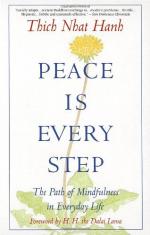
|
| Name: _________________________ | Period: ___________________ |
This test consists of 15 multiple choice questions and 5 short answer questions.
Multiple Choice Questions
1. While driving, what can be used as a bell of mindfulness?
(a) A red light.
(b) A speed limit sign.
(c) A yield sign.
(d) A car horn.
2. According to Hanh in "Aimlessness", what does the current culture promote?
(a) Meditation.
(b) Achievement.
(c) Constant activity.
(d) Wealth.
3. Who was the first monk to ride a bicycle in Vietnam?
(a) Thich Nhat Hanh.
(b) Nhat Hanh Nguyen.
(c) Thich Nguyen.
(d) H.H. the Dalai Lama.
4. According to Hanh, what is the result of realizing the present moment?
(a) A chance to clear the mind.
(b) A chance to eradicate the past.
(c) A chance to be happy now.
(d) A chance to be happy in the future.
5. What act does Hanh's teaching center around?
(a) Frequent reflecting.
(b) Thoughtful praying.
(c) Conscious breathing.
(d) Selective speaking.
6. What are the spiritual friends that Hanh uses on his mindfulness path?
(a) Dirty dishes, red lights, and traffic jams.
(b) Quiet surroundings, and meditations.
(c) Meditations and bells.
(d) Dirty dishes and bells.
7. What is essential to productivity?
(a) Nimble body movements.
(b) Quick thinking.
(c) Meditation.
(d) Linking the mind and body.
8. What path does the atmosphere of peace travel?
(a) Individual, family, world, community.
(b) Family, individual, community, world.
(c) Individual, family, community, world.
(d) World, community, family, individual.
9. Why is Hanh received enthusiastically in the West?
(a) His personal realtionships with influential leaders.
(b) His belief in isolationism.
(c) His ablility to walk calmly with peace and awareness.
(d) His continued efforts to bring peace to Vietnam.
10. What becomes available when we quiet our distracted thinking?
(a) Patience and kindness.
(b) Contentment and security.
(c) Peace and happiness.
(d) Love and health.
11. What does the author suggest using as a bell of mindfulness when driving in Paris?
(a) Yield sign.
(b) Car horn.
(c) Stop sign.
(d) "Je me souviens" license plate.
12. Who/what is one never able to escape?
(a) Guilt.
(b) One's self.
(c) Mindfulness.
(d) Gratitude.
13. What community is established by Hanh a hundred miles southwest of Paris?
(a) Sweet Potato.
(b) Left Bank.
(c) Sweet Pears.
(d) Le Casserole.
14. According to Hanh, which of the following is a non-sound?
(a) A ray of sunshine.
(b) A falling leaf.
(c) A car buzzer.
(d) A telephone ring.
15. In "The Eucharist", what does one bite of bread give to each disciple?
(a) Nourishment.
(b) Real life.
(c) Encouragement.
(d) Faith.
Short Answer Questions
1. What invitation does the author give to the reader at the end of the first section?
2. According to the author, which rite is a wonderful practice of mindfulness that Jesus used to awaken his disciples?
3. According to Hanh, how many rings should one allow before answering the telephone?
4. What does practicing conscious breathing unify?
5. What does Hanh synchronize with his movements of using a scythe?
|
This section contains 474 words (approx. 2 pages at 300 words per page) |

|




